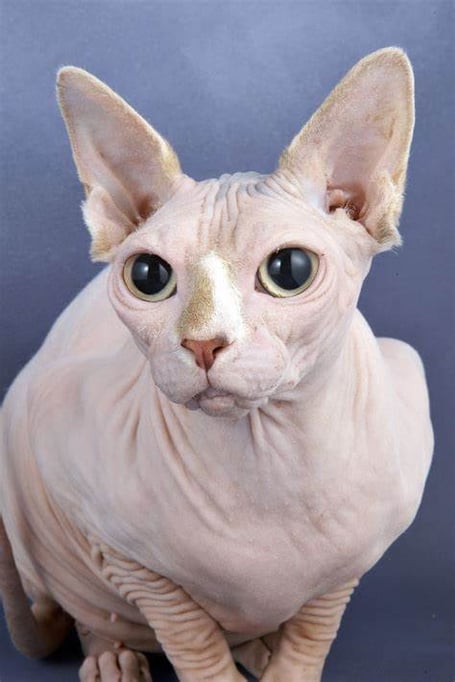When is a cat not a cat? Perhaps when it’s a Sphynx – totally hairless, very wrinkly and with the behaviour traits of a dog.
The breed originated in Canada of all places, a county where one would think a warm coat is a requirement in the winter months, both for felines and humans.
The Sphynx’s origins date back to 1966 when a litter of domestic shorthairs was born in Toronto, and one of them was hairless due to a genetic mutation.
This cat was then used in a selective breeding process over several years whereby hairless cats were bred with normal-coated ones, some from the USA and Europe, and then their offspring bred back again to hairless cats.
According to the Cat Fanciers’ Association breed standards, the Sphynx’s skin should have the texture of chamois leather; its whiskers may be present or absent; it should have large, lemon-shaped eyes and huge ears; its feet should be webbed; and its skin can be the colour that fur would be – solid, tabby, tortie, etc.
And as if those features aren’t enough to make the Sphynx a very strange cat, another oddity is that it acts like a dog - following its owner everywhere, waiting by the door for its owner to return, and being friendly towards strangers.
These cats are fantastic companion animals and demand almost constant attention, but they are not the easiest of pets to look after.
Their lack of coat means that they have to keep warm by artificial means, which is the main reason they are so cuddly and companionable around humans. However, they can overheat easily and so an owner needs to be very vigilant about room temperatures.
And one might think that a hairless cats means less shedding and grooming, and therefore lower maintenance. But the opposite is true because an absence of body hair means that the cat’s natural oils accumulate on the surface of their skin.
With short and long haired breeds, the hair absorbs the oils creating glossy, shinny coats. The Sphynx, though, needs to have a bath regularly in order to remove the excess oils and to prevent acne.
Nor is the Sphynx an ideal cat for an owner with allergies, because they are not hypoallergenic. Allergies to cats are triggered by a protein found in a cat’s saliva and sebaceous glands, not cat hair itself.
So, there is a myriad of reasons not to own a Sphynx cat, and that’s why this article has focused on them before mentioning that the ManxSPCA has two such cats looking for a new home together.
They are seven-year-old females, and have been much-loved family pets. Their owners have had a change in circumstances and have reluctantly asked us to find a new home for their beloved pets.
The girls will need to remain as indoor only cats, and ideally they should have human companionship (servitude?) most of the time.
They would, therefore, suit someone who works from home, or is house bound, or who is retired. They have both been given a clean bill of health by a vet, and they will be re-homed with a month’s free pet insurance, but a new owner will need to be prepared for higher premiums because of the Sphynx’s pedigree. The breed is pre-disposed to heart conditions, although this is more prevalent in males.
They also eat twice as much as ‘normal’ cats because of the need to maintain their body temperature.
The cattery team will be monitoring interest in the Sphynx cats carefully, and only genuine potential adopters will meet them.
Please email the cattery on [email protected] with a completed home finder questionnaire (available on our website) if you would like to progress your interest, and please note that the girls don’t like other cats, and haven’t lived with dogs or children before.


.jpeg?width=209&height=140&crop=209:145,smart&quality=75)
.JPG?width=209&height=140&crop=209:145,smart&quality=75)

Comments
This article has no comments yet. Be the first to leave a comment.